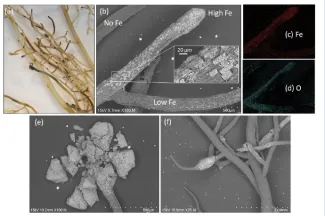Localized Fe plaque formation was identified on roots obtained from Arctic tundra, indicating the potential for these roots to release oxygen gas and alter subsurface redox biogeochemistry.
Arctic ecosystems contain substantial belowground biomass in the form of roots that mediate nutrient uptake and facilitate gas exchange between saturated soils and the atmosphere. However, the role of plant roots in modifying belowground biogeochemistry in the Arctic tundra is relatively unexplored. Carex aquatilis roots were collected during a 2021 field campaign from zero-power warming chambers deployed from June to September on inundated, low-lying areas in Utqiaġvik, Alaska. Roots exhibited black staining that was concentrated near root tips. Scanning electron microscopy (SEM) with energy dispersive spectroscopy was used to examine the distribution and chemical composition of these black stains. The researchers determined that stains were comprised of Fe and oxygen with minor amounts of phosphorus. Iron plaques formed a mix of thin coatings and thick concretions that were primarily but not exclusively observed at root tips. Wetland plants form Fe plaques as a byproduct of radial root oxygen loss into saturated, anoxic soils. Oxygen gas released from roots can oxidize dissolved Fe2+ in soil solution to form Fe(III) oxyhydroxides that coat root surfaces. These Fe(III) oxyhydroxides can subsequently serve as terminal electron acceptors for anaerobic respiration during plant senescence, leading to mineral dissolution or transformation into Fe(II) phases. Based on their color and composition, the observed Fe plaques likely represent Fe(II/III) oxides that were formed during partial reduction of initial Fe(III) oxyhydroxides. Furthermore, Fe-associated phosphorus denotes sorption of nutrient phosphate onto the mineral surface and may indicate that root-associated Fe oxides serve as phosphorus reservoirs and regulate phosphorus solubility. Additional studies are needed to quantify the distribution of Fe plaques as a function of root order and time during the growing season. These analyses will provide insight into the timing and extent of radial root oxygen loss into the subsurface and the formation and transformation of Fe oxides.


